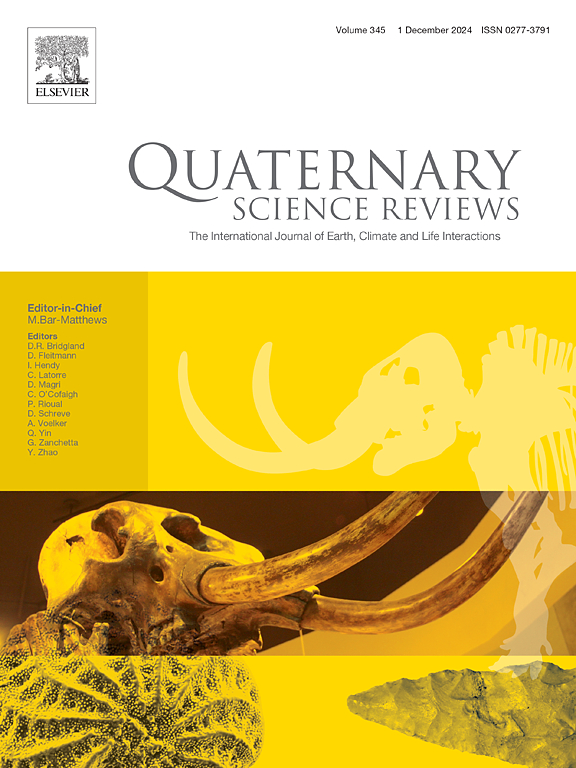Scales of toolstone transport in the Armenian Highlands during MIS 3: The contribution of Ararat-1 Cave (Ararat Depression) to reconstructing opportunities for social interactions
IF 3.2
1区 地球科学
Q1 GEOGRAPHY, PHYSICAL
引用次数: 0
Abstract
Marine Isotope Stage (MIS) 3, ranging from around 57,000 to 29,000 years ago, is a period of significant archaeological interest due to notable transitions in lithic technology and hominin populations. In Europe, this time saw the replacement of Middle Palaeolithic (MP) technologies associated with Neanderthals by Upper Palaeolithic (UP) technologies linked to anatomically modern humans (AMHs). This technological shift is conventionally attributed to a demographic turnover; however, the timing of this transition varied regionally. The presence of Neanderthals and AMHs in the Levant, western Europe, and elsewhere over extended periods complicates the narrative, suggesting asynchronous and regionally diverse associations of hominin species and lithic technologies. This study shifts the attention to potential technological and cultural transmissions among MP- and UP-making groups, emphasizing the roles of social and exchange networks. Recent data from the obsidian-rich Armenian Highlands enable us to consider the mobility and land use of these groups without the added complication of toolstone with different knapping qualities, so patterns more clearly reflect mobility patterns, land use strategies, and potential social connections of foraging groups. These results suggest that, while MP-making groups in MIS 3 had overlapping territories, the UP-making groups at Aghitu-3 had smaller movements on the landscape. In contrast, MIS 2 sites with UP lithic assemblages have resource territories that apparently overlapped much like those of the MIS 3 MP sites. The findings hint at the possibility that differing mobility and land use during MIS 3 might have contributed to the coexistence of distinct lithic technologies, potentially through social transmission rather than a direct replacement of hominin populations.
MIS 3期间亚美尼亚高地的工具石运输规模:Ararat-1洞穴(Ararat洼地)对重建社会互动机会的贡献
海洋同位素阶段(MIS) 3,从大约57000年到29000年前,由于石器技术和人类种群的显著转变,是一个具有重要考古意义的时期。在欧洲,与尼安德特人相关的中旧石器时代(MP)技术被与解剖学上的现代人(AMHs)相关的上旧石器时代(UP)技术所取代。这种技术转变通常被归因于人口流动;然而,这种转变的时间因地区而异。尼安德特人和amh在黎凡特、西欧和其他地方的长期存在使叙述变得复杂,表明人类物种和石器技术的联系是不同步的和区域多样化的。本研究将注意力转移到中高档制造群体之间潜在的技术和文化传播,强调社会和交换网络的作用。来自富含黑曜石的亚美尼亚高地的最新数据使我们能够考虑这些群体的流动性和土地利用,而不需要考虑具有不同敲击质量的工具石的复杂性,因此模式更清楚地反映了觅食群体的流动性模式、土地使用策略和潜在的社会联系。这些结果表明,虽然MIS 3的mp制造群体有重叠的领土,但Aghitu-3的up制造群体在景观上的移动较小。相比之下,具有UP岩石组合的MIS 2站点的资源区域明显与MIS 3 MP站点重叠。研究结果暗示,在MIS 3期间,不同的流动性和土地利用可能促成了不同石器技术的共存,这可能是通过社会传播而不是直接取代古人类种群。
本文章由计算机程序翻译,如有差异,请以英文原文为准。
求助全文
约1分钟内获得全文
求助全文
来源期刊

Quaternary Science Reviews
地学-地球科学综合
CiteScore
7.50
自引率
15.00%
发文量
388
审稿时长
3 months
期刊介绍:
Quaternary Science Reviews caters for all aspects of Quaternary science, and includes, for example, geology, geomorphology, geography, archaeology, soil science, palaeobotany, palaeontology, palaeoclimatology and the full range of applicable dating methods. The dividing line between what constitutes the review paper and one which contains new original data is not easy to establish, so QSR also publishes papers with new data especially if these perform a review function. All the Quaternary sciences are changing rapidly and subject to re-evaluation as the pace of discovery quickens; thus the diverse but comprehensive role of Quaternary Science Reviews keeps readers abreast of the wider issues relating to new developments in the field.
 求助内容:
求助内容: 应助结果提醒方式:
应助结果提醒方式:


